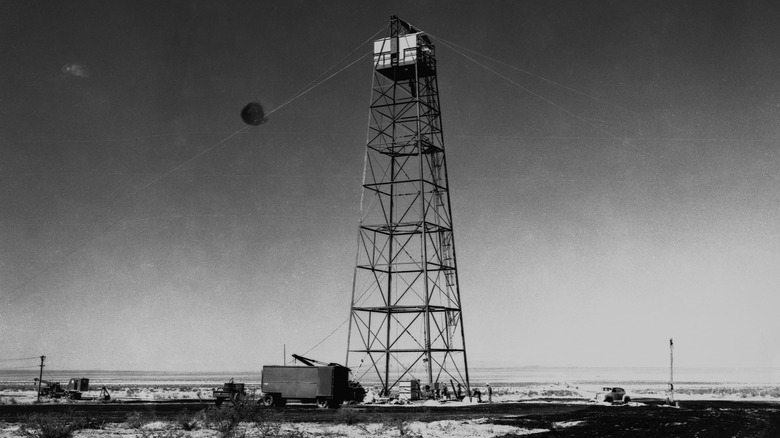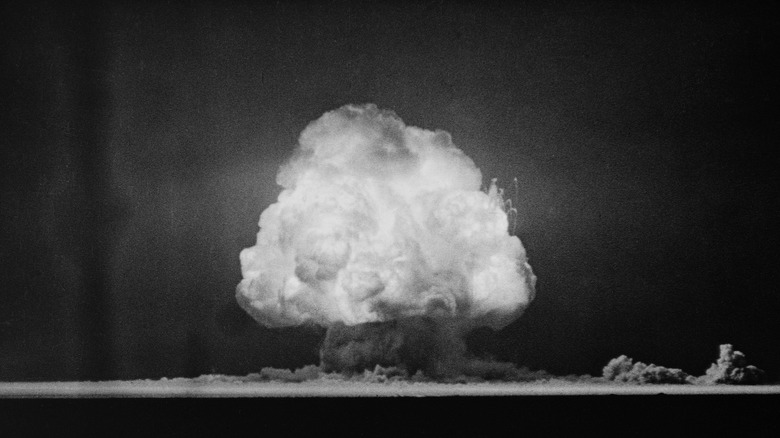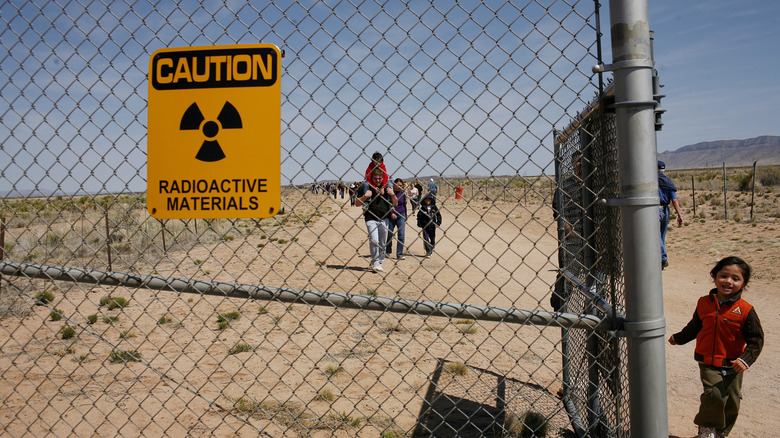The Trinity Downwinders: Oppenheimer Ignores The Bomb's Sadly Forgotten Victims
In Christopher Nolan's "Oppenheimer," The Trinity Test at Los Alamos, New Mexico, is a triumph. A moment of pure success unique in its separation from death and human suffering; an isolated display of the genius simultaneously praised and feared by the film's narrative. For one scene, and one scene only, the most dangerous scientific discovery the world has ever known supposedly has no victims. However, that could not be further from historical fact.
There is likely no place in the world where one could detonate a nuclear bomb — especially not one the size of J. Robert Oppenheimer's (Cillian Murphy) in the film — and have it be harmless. It's true that the blast zone at Los Alamos was clear, but neither the scientists in the film nor their historical counterparts took into account how wind patterns would carry the biblical amounts of radiation from their isolated scientific haven into unsuspecting communities nearby.
The self-described Tularosa Basin Downwinders (or Trinity Downwinders) is a community of New Mexico citizens that, despite neither consenting nor being so much as informed of the atomic bomb detonation near their homes, have been suffering the real, human consequences of the Trinity Test without justice for over 75 years.
The fallout of the Trinity Test traveled further than anyone realized
As noted in the "Oppenheimer" film, Los Alamos was chosen in part because it could be the place of a testing site uninhabited for 50 miles in every direction. Scientists were confident that those outside the blast radius would be safe from immediate harm — the fallout, however, they were far less certain about. After detonating the massive weapon — loaded with four times the amount of plutonium necessary for a fission reaction — nuclear fallout rained down from the blazing atmosphere over a 200-square-mile area northeast of the test.
This was particularly harmful for the predominantly Hispanic and Indigenous communities in rural New Mexico, whose produce, drinking water, and livestock were contaminated by radioactive fallout. Those affected were not evacuated or even so much as notified by the U.S. government of the atomic bomb's existence in the aftermath of its detonation, starting a cycle of death, struggle, and institutional abandonment that continues to this day.
Sickness, death, and financial hardship plagued New Mexico
Though the bomb supposedly ended America's troubles in August 1945, the Trinity Downwinders' had just begun. In the years that followed, exposure to traveling radiation and contaminated resources caused disturbing health problems for New Mexicans in the affected area. Infant mortality in the state skyrocketed by 56%; rare diseases began to develop in otherwise healthy, young individuals; and, of course, cancer cases were abnormally prevalent.
Surviving such illnesses was only half the battle. Rural communities lacked access to necessary local health care and would have to make long journeys to expensive doctors in order to get the help they needed. If they were able to do so, they would still face difficulty finding and maintaining employment as their symptoms worsened.
For many in the Tularosa Basin, medical hardships were rivaled and even dwarfed by financial hardships. According to some community members, it became common for parents to be unable to support their children's college education. Given the Trinity Test's role in their plight, it would be reasonable to assume the government would step in to provide some kind of assistance. Yet several decades later, the victims are still fighting to be heard.
The Tularosa Basin Downwinders Consortium is still fighting for justice
In 1990, the Radiation Exposure Compensation Act (RECA) was passed to financially assist those struggling from the effects of radiation poisoning caused by governmental nuclear testing in the 1950s. Unfortunately, this act failed to include the victims of the Trinity Test, and nearly eight decades of attempts to rectify this have been rejected by the U.S. government. The issue is especially dire at this moment — less than a year after the release of "Oppenheimer," the RECA program will expire, and no one will be able to claim compensation for the harm caused by nuclear testing.
Thankfully, a group of activists known as the Tularosa Basin Downwinders Consortium (TBDC) scored a victory in July 2023 when an official map of the Trinity Test fallout was finished and released to the public. In an interview with Axios, TBDC co-founder Tina Cordova described "Oppenheimer" as "nothing but an over-glorification of the science and the scientists, again, with no reflection on the harm done to the people in New Mexico."
Despite many attempts by Cordova and other survivors to contact the production, hoping to convince them to include some mention — even just a card before the credits — acknowledging "the sacrifice and suffering of the people of New Mexico," no one from "Oppenheimer" responded or reached out.



